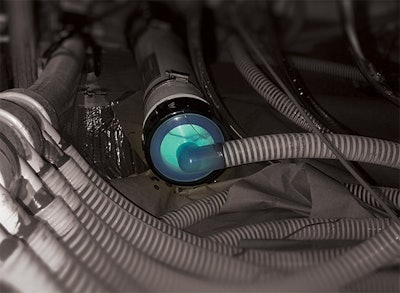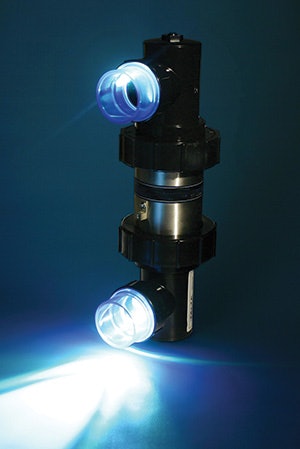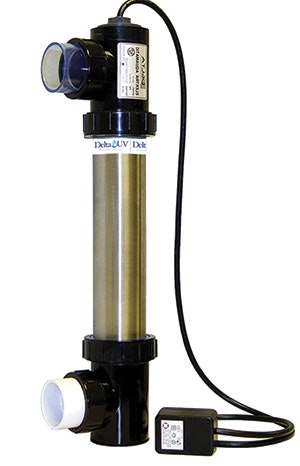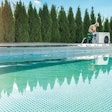
Manufacturers in the portable spa industry have made a splash in recent years with the introduction of UV systems as a sanitizing aid, allowing less halogen use in the tub. Proponents of the technology are quick to point out that UV is a perfect fit for the job, given the demands of the hot water environment.
“We’ve been selling UV systems to portable spa manufacturers for about 10 years with an increasing number moving in that direction over the past two to three years,” explains Jeff Boynton, general manager at Delta UV, a manufacturer of UV systems based in Gardena, Calif. “Today, we’re manufacturing about 20 different sizes as an OEM to accommodate different flow rates in various spa models.
“It’s definitely a growing part of the business,” he adds, “one that’s keeping up with other markets that are also turning to UV.”
The Internet, oddly enough, has been a helpful boost to the growth and acceptance of UV in spas. Boynton believes that younger consumers accustomed to researching everything and anything online are pushing the trend. “We’ve become a society of what I call ‘information-vores,’” he says. “Consumers interested in the technology seem to be a younger breed; they consume information about how UV actually works.
“When you combine that with the overall trend toward green technology and the benefits of UV treatment, we have a situation where the technology is becoming better known, understood and now manufacturers are responding to that increase in demand.”
A REGISTRY OF BENEFITS
When consumers do their research or are otherwise educated by the industry, here’s what they are likely to learn:
• Reduced halogen use: As is the case in swimming pools, one of the biggest benefits of a UV system is that it can dramatically reduce use of chemicals, specifically chlorine or bromine.
“People are looking for a cleaner way to treat water,” explains Boynton. “They don’t want to add anything to the water, or as little as possible. UV helps move you in that direction.”
And that direction lines up neatly with spa manufacturers looking to capture consumers concerned about the effects of traditional halogen treatment. “Our goal using UV technology is to achieve a 75 to 80 percent reduction in the chemical load of the vessel,” explains Jerry Keller, product development/customer care manager for MAAX Spas, a portable spa manufacturer based in Chandler, Ariz. “It affects the water in a positive way without adding anything; it doesn’t take anything away from the water, so in that regard, it’s benign.”
• Sanitizing byproduct reduction and odor abatement: UV has the ability to inhibit the formation of combined chlorine and bromine, which in conjunction with lowered chemical consumption can reduce or even eliminate foul-smelling halogen byproducts.
The ability to prevent chloramines and bromamines from forming is especially important in a spa, notes Boynton. “The warmer water increases evaporation, which in turn can lead to bathers inhaling more sanitation byproducts,” he says. When less chlorine or bromine is used, less combined chlorine and bromine will be produced. “The bottom line is that if you use less halogen, you’re going to generate less byproduct. It’s really just common sense.”




By reducing chemical use, then, manufacturers are able to sell on the premise that in a UV-equipped spa, the offensive odor associated with halogen by-products will be drastically reduced along with eye and skin irritation.
“Number one concern for consumers is the use of chlorine and the associated odor,” explains Keller. “For the most part, consumers don’t really understand the difference between chlorine and chloramines. They smell chlorine and think it’s too much. It’s difficult to change their minds on that. But it’s much easier for them to understand that we’re taking the chlorine that they’re using and making it more effective. That’s essentially what UV does. So in their mind, they see a large reduction in chlorine use and they’re not experiencing the smell.”
• Rapid turnover: Because UV treatment depends entirely on direct exposure of the water to UV light in the system’s contact chamber, the rapid turnover commonly found in spas compared to pools enhances these positive effects.
“With spas, you have a situation where the water is turned over two, three, four or even up to ten times per hour, so we have the potential for the water being sanitized dozens or even hundreds of times each day,” notes Boynton. “The more often water passes through the system, the greater the reduction in chemical use.”
• High bather loads: The rapid turnover rate helps UV systems contend with one of the biggest burdens of spa sanitization: the high ratio of bathers to water volume, a factor that is exacerbated even further by higher water temperatures in spas.
“Not only do you have a higher bather-to-water ratio than you do in pools, but people sweat more in spas and introduce other bodily contaminants,” Boynton says. “The smaller volume and higher temperatures elevates the need for constant treatment.”
• Steady water balance: By reducing halogen use, UV has the indirect effect of helping keep water balance in line. Because the treatment is passive, the systems add nothing to the water and therefore have zero impact on pH, total alkalinity, calcium hardness or TDS.
All of these factors conspire to create beneficial synergistic effects: By reducing the sanitizer demand and therefore halogen byproducts, odor and other forms of irritation are likewise reduced or eliminated. That, combined with the rapid turnover in spas, further enables the system to help contend with bather contamination.
More importantly, UV has been proven effective in killing pathogens that have shown resistance to chlorine, such as the now infamous cryptosporidium. This crucial benefit has helped drive UV’s popularity in both pools and spas, and lead to its growing acceptance among health departments and public health agencies such as the Centers for Disease Control.
MAKING THE MARK
Like all sanitizing technologies, however, UV treatment has its limitations and must be sized and maintained properly in order to achieve the benefits. And not all UV systems are created equal. “There are UV lights that do not generate the millijoules required to properly sanitize water and will do very little,” says Boynton. “There’s a huge difference in price between units that effectively kill bacteria, viruses and other microorganisms, and those that are just decorations.
“The flow rate is critical when we talk about optimizing the effect of the technology,” says Keller. “The bulb should be sized to the flow rate, so that it will do an effective job treating the water, which in turn is tied to the overall size of the spa. For example, the unit we use on our swim spa is probably four to five times the size of the units we use on small hot tub. It’s a different application and requires a different spec.”
Boynton agrees, noting that in the past improperly designed and sized UV units have resulted in systems that don’t perform as advertised: “If you undertreat the water with a system that’s too small, you won’t have the same benefits of reduced chemical consumption,” he explains. “On the other hand, if you overtreat the water, it will strip out some of the halogen and you could actually wind up increasing chemical consumption.”
In addition to proper sizing relative to flow rate, the output of the UV lamps used is essential in eliminating target pathogens. “We design our systems to generate 30 millijoules,” Boynton adds. “At that level, the UV will eradicate cryptosporidium and other harmful pathogens, such as cholera. We’re slightly overshooting the output to err in favor of bather safety. But at that level with a proper flow rate, there’s no danger of stripping halogen.”
As for halogens, although the main benefit of UV technology is the reduction of necessary sanitizer residuals, even the staunchest supporters of the technology are quick to point out that UV must be used in conjunction with some form of sanitizer that provides a chemical residual.
UV does not provide bather-to-bather protection and when the system is off, it does nothing at all, ergo a chemical sanitizer, albeit at a lower level, remains necessary.
Specific conditions will dictate just how low one can go with sanitizer levels. In all likelihood, residential spas will require a lower residual than will commercial vessels that might receive many times the batherload.
SUSTAINED ACCEPTANCE
Although UV in pools and particularly spas is arguably a newcomer to the water treatment equation, advocates of the technology believe it’s here to stay.
“It’s something we see tremendous potential moving forward,” says Keller. “The technology is going to continue to advance. UV is here to stay for us because we believe this is the right answer for our product. We have absolutely no intention of getting away from UV.”
Better Together
UV and ozone generation are widely used together in hot water applications, both in portable spas and in-ground gunite spas, both in commercial and residential settings. The synergistic relationship between the two technologies stands as its own scientific field, known as advanced oxidation process, a complex set of chemical reactions through which highly oxidative and extremely short lived chemical species known as hydroxyl radicals are formed.
Although not covered in this discussion, AQUA examined the relationship between UV and ozone in our July 2014 issue in “The Quest for Synergy.”
Comments or thoughts on this article? Please e-mail [email protected].












































